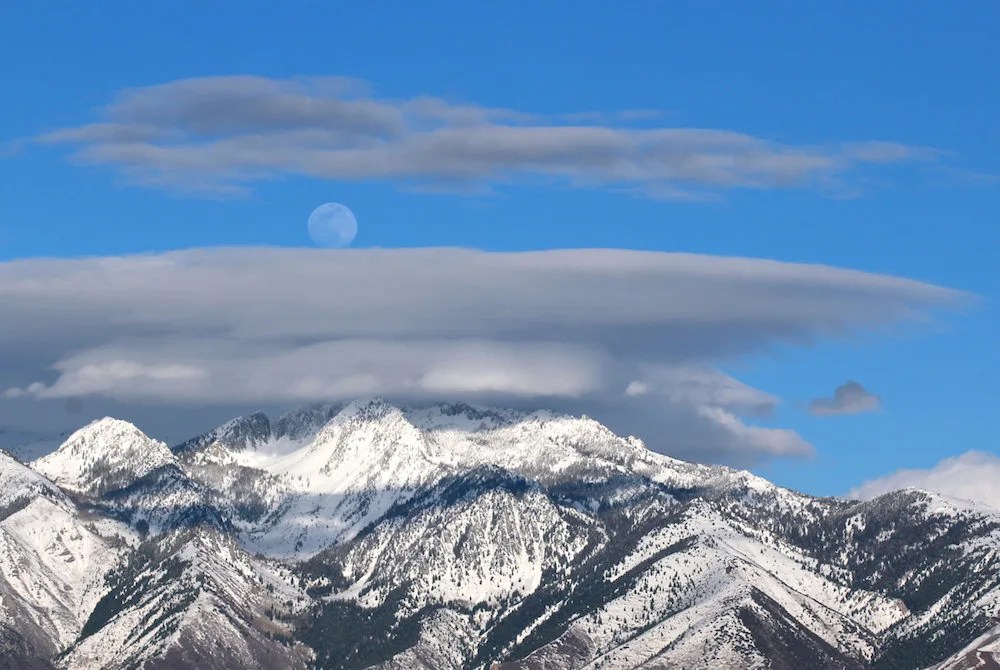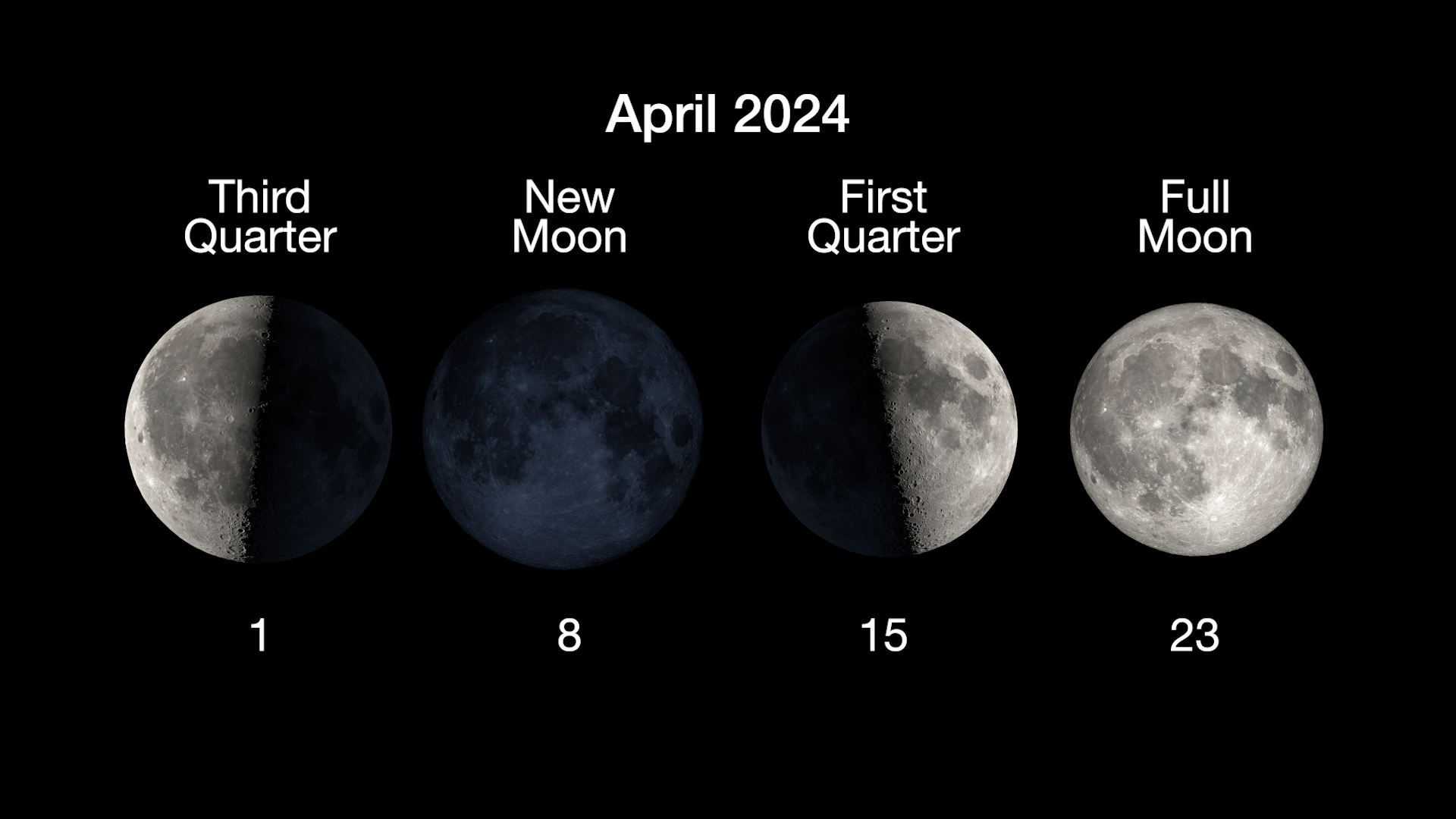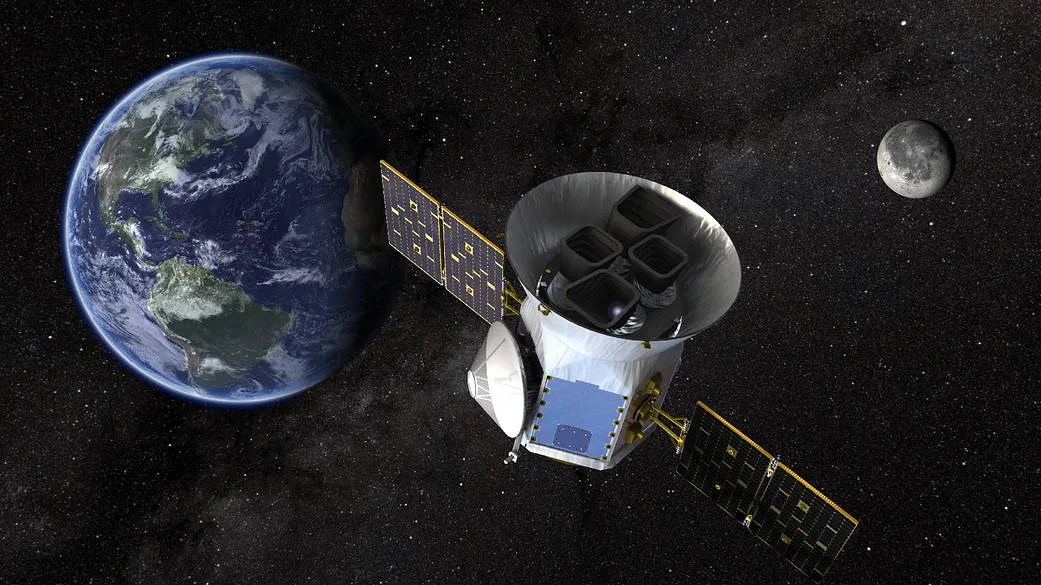13 min read

The next full Moon will be on Friday morning, April 19, 2019, appearing "opposite" the Sun (in Earth-based longitude) at 7:12 AM EDT. The Moon will appear full for about three days around this time, from Wednesday evening through Saturday morning.
The Maine Farmer's Almanac first published "Indian" names for the full Moons in the 1930's. Some writers tie these names to the months of our modern calendar, but I think it more likely these names were tied to the seasons. Right now, the names by season and names by month are out of sync, but they will align again later this spring, as this will be a season with four full Moons.
Going by the seasons, as the second full Moon of spring, the Native American tribes of the northeastern United States called this the Flower Moon, as flowers are abundant this time of year in most of these areas. Other names include the Corn Planting Moon or the Milk Moon.
Going by the European months, the full Moon in April is called the Pink Moon, a name that comes from the herb moss pink, also known as wild ground phlox, which in the Eastern U.S. is one of the earliest widespread flowers of Spring. Other names for this Moon include the Sprouting Grass Moon, the Egg Moon, and among coastal tribes the Fish Moon, as this was the time that the shad swam upstream to spawn.
In many lunisolar calendars the months change with the new Moon and full Moons fall in the middle of the lunar months. This full Moon is the middle of the third month of the Chinese calendar and the middle of the Hebrew month of Nisan. Pesach or Passover begins on the 15th day of the month of Nisan and is celebrated for 7 or 8 days (in the Hebrew calendar days begin with sunset rather than at midnight, hence 7 sundown-to-sundown days spans 8 civil calendar days). Since the Hebrew calendar is based on lunar months, the beginning of Passover is usually near the first full Moon of spring. This year, Passover begins at sunset on Friday, April 19, and ends the evening of Saturday, April 27, 2019.
In the Christian ecclesiastical calendar this is the Paschal Moon, from which the date of Easter is calculated. Paschal is the Latinized version of Pesach. Generally, the Christian holiday of Easter, also called Pascha, is celebrated on the first Sunday after the first full Moon of spring. However, there are slight differences between the times of these astronomical events and the calendars used by the Eastern and Western churches. This is one of the years where it makes a difference. Western Christianity will be celebrating Easter on Sunday, April 21, 2019, the Sunday after the second full Moon of spring, while Eastern Christianity will be celebrating Easter a week later, on Sunday, April 28, 2019.
There are a number of variations of the Hindu lunisolar calendar, but for many this full Moon corresponds with Hanuman Jayanti, celebrating the birth of Lord Sri Hanuman.
For Buddhists, especially in Sri Lanka, this full Moon is Bak Poya, commemorating when the Buddha visited Sri Lanka and settled a dispute between chiefs, avoiding a war.
In the Islamic calendar the months start with the first sighting of the waxing crescent Moon a few days after the New Moon. This full Moon is near the middle of Sha'ban, the eighth month of the calendar, and some Moslems celebrate it as Mid-Sha'ban or Bara'at Night (Laylat al-Bara’at).
As usual, the wearing of suitably celebratory celestial attire is encouraged in honor of the full Moon.
As for other celestial events between now and the full Moon after next:
As spring continues, the daily periods of sunlight continue to lengthen. On the day of the full Moon, Friday, April 19, 2019, morning twilight will begin at 5:25 AM, sunrise will be at 6:26 AM, the Sun will reach a maximum altitude of 62.4 degrees at 1:07 PM, sunset will be at 7:49 PM, and evening twilight will end at 8:50 PM EDT. By the day of the full Moon after next, Saturday, May 18, 2019, morning twilight will begin at 4:46 AM, sunrise will be at 5:53 AM, the Sun will reach a maximum altitude of 70.7 degrees at 1:05 PM, sunset will be at 8:16 PM, and evening twilight will end at 9:24 PM EDT.
On the evening of the full Moon on April 19, 2019, as evening twilight ends, the bright stars of the local arm of our galaxy, including the constellation Orion, will appear near the horizon in the west-southwest. The planet Mars will appear a little north of west at about 28 degrees above the horizon. As the month progresses, Mars will continue to shift gradually towards the west-northwest, appearing near the bright star Aldebaran by mid-April. By the night of the full Moon on May 18, 2019, as evening twilight ends, most of the bright stars of the local arm will have already set and Mars will appear in the west-northwest about 16 degrees above the horizon.
On the morning of the full Moon on April 19, 2019, as morning twilight begins, the planet appearing brightest in the sky will be Venus, but it will be difficult to see as it will appear in the east only about 1 degree above the horizon. The second brightest planet will be Jupiter, appearing in the south about 28 degrees above the horizon. The planet Saturn will appear in the south-southeast at about 27 degrees above the horizon. The bright star appearing nearly overhead will be Vega in the constellation Lyra. Mercury will rise in the east about 10 minutes after morning twilight begins and should be visible until about 30 minutes before sunrise, appearing to the lower left of Venus. As the month progresses, Jupiter, Saturn, and the background of stars will appear to shift towards the west, while Venus gradually skirts slightly towards the north as it moves closer to the eastern horizon. By the morning of the full Moon on May 18, 2019, as morning twilight begins, Jupiter will appear in the south-southwest about 23 degrees above the horizon and Saturn will appear in the south about 30 degrees above the horizon. Venus will be rising about 7 minutes after morning twilight begins but should be visible low in the east-northeast until about 30 minutes before sunrise. Mercury will not be visible, lost in the glow of the Sun.
Even though they are not visible usually, I include in these Moon missives information about Near Earth Objects (mostly asteroids) that pass the Earth within 10 lunar distances (and a few larger ones passing within 15 lunar distances), because I find it interesting that we have discovered so many. On Thursday morning, April 18, 2019, at 2:41 AM EDT (2019-Apr-18 06:41 UTC), Near Earth Object (2019 GC6), between 42 and 93 feet (13 to 28 meters) in size, will pass the Earth at 0.6 lunar distances, traveling at 12,582 mph (5.62 kilometers per second).
On Thursday mid-day, April 18, 2019, at 12:10 PM EDT (2019-Apr-18 16:10 UTC), Near Earth Object (2012 XO134), between 138 and 309 feet (42 to 94 meters) in size, will pass the Earth at 14.7 lunar distances, traveling at 24,505 mph (10.95 kilometers per second).
On Thursday afternoon, April 18, 2019, at 1:38 PM EDT (2019-Apr-18 17:38 UTC), Near Earth Object (2019 FN2), between 159 and 355 feet (48 to 108 meters) in size, will pass the Earth at 4.0 lunar distances, traveling at 17,318 mph (7.74 kilometers per second).
On Thursday evening, April 18, into Friday morning, April 19, 2019, the bright star near the full Moon will be Spica.
As mentioned above, the next full Moon will be on Friday morning, April 19, 2019, at 7:12 AM EDT, appearing full from Wednesday evening through Saturday morning. This year the light of the full Moon will interfere with the visibility of the annual Lyrid meteor shower, which peaks a few days after the full Moon.
On Friday morning, April 19, 2019, at 7:13 AM EDT (2019-Apr-19 11:13 UTC), Near Earth Object 522684 (2016 JP), between 525 and 1,175 feet (160 to 358 meters) in size, will pass the Earth at 19.0 lunar distances, traveling at 25,728 mph (11.5 kilometers per second).
On Sunday night into Monday morning, April 21 to 22, 2019, the bright star that will appear about 8 degrees below the waning gibbous Moon will be Antares. For the Washington, DC area, the Moon will rise in the east-southeast Sunday night at 10:28 PM, Antares will rise at 11:10 PM, the Moon will reach its highest in the sky for the night Monday morning at 3:38 AM, and morning twilight will begin around 5:20 AM EDT.
The annual Lyrid meteor shower is expected to peak Monday night into Tuesday morning, April 22 to 23, 2019. Since the just past full Moon will be in the night sky at the same time that we expect the meteors to be entering the atmosphere, this is not a good year for viewing the Lyrics.
On Monday night into Tuesday morning, April 22 to 23, 2019, the bright planet Jupiter will appear below the waning gibbous Moon, appearing to move closer together as the night progresses. For the Washington, DC area, the Moon will rise in the east-southeast Monday night at 11:31 PM, Jupiter will rise at 11:54 PM, the Moon will reach its highest in the sky for the night Tuesday morning at 4:31 AM, and morning twilight will begin around 5:19 AM EDT.
On Tuesday morning, April 23, 2019, at 6:38 AM EDT (2019-Apr-23 10:38 UTC with 2 minutes uncertainty), Near Earth Object (2019 GM4), between 174 and 389 feet (53 to 119 meters) in size, will pass the Earth at between 9.0 and 9.1 lunar distances (nominally 9.1), traveling at 18,826 miles per hour (8.42 kilometers per second).
On Thursday morning, April 25, 2019, the planet Saturn will appear to the lower left of the waning gibbous Moon, appearing to shift closer together as the morning progresses. For the Washington, DC area, the Moon will rise in the east-southeast at 1:22 AM, Saturn will rise at 1:35 AM, and morning twilight will begin around 5:16 AM EDT.
Friday evening, April 26, 2019, the waning Moon will appear half-full as it reaches its last quarter at 6:18 PM EDT.
On Saturday morning, April 27, 2019, at 7:29 AM EDT (2019-Apr-27 11:29 UTC with 4 minutes uncertainty), Near Earth Object (2019 GF1), between 26 and 59 feet (8 to 18 meters) in size, will pass the Earth at 4.7 lunar distances, traveling at 4,268 mph (1.91 kilometers per second).
On Sunday morning, April 28, 2019, at about 3:16 AM EDT (2019-Apr-28 07:16 UTC with 15 minutes uncertainty), Near Earth Object (2019 GX5), between 63 and 141 feet (19 to 43 meters) in size, will pass the Earth at between 7.1 and 7.3 lunar distances (nominally 7.2), traveling at 23,855 mph (10.66 kilometers per second).
Sunday afternoon, April 28, 2019, at 2:21 PM EDT, the Moon will be at apogee, its farthest from the Earth for this orbit.
On Thursday morning, May 2, 2019, if you have a very clear view of the eastern horizon, you might be able to see the bright planet Venus near the thin, waning, crescent Moon. You might need a telescope or binoculars to see them. For the Washington, DC area, Venus will rise at 5:07 AM (just after morning twilight begins), the Moon will rise to the lower right of Venus at 5:19 AM, and by around 5:40 AM EDT the sky will have brighten to the point where you can no longer see them. The next morning, the Moon will appear near the planet Mercury, but I think the sky will be too bright to see them.
Saturday evening, May 4, 2019, at 6:46 PM EDT, will be the new Moon, when the Moon passes between the Earth and the Sun and will not be visible from the Earth. The New Moon marks the start of the new month for most lunisolar calendars. Sundown on May 4 marks the start of Iyyar in the Hebrew calendar. The fourth month of the Chinese calendar starts on May 5 (at midnight in China's time zone, which is 12 hours ahead of EDT)
Sometime on Sunday, May 5, 2019, (2019-May-05 14:40 UTC with 8 hours 45 minutes uncertainty), Near Earth Object (2018 KK1), between 174 and 389 feet (53 to 119 meters) in size, will pass the Earth at between 11.5 and 16.3 lunar distances (nominally 13.9), traveling at 31,058 mph (13.88 kilometers per second).
The Eta-Aquariid meteor shower will peak a day or so after the New Moon, so the skies will be dark at the best viewing times (a few hours before dawn), but the Washington, DC area is a little far north to get a good view of this southern hemisphere meteor shower.
In the Islamic calendar the months start with the first sighting of the waxing crescent Moon a few days after the New Moon. For North America, Sunday evening, May 5, 2019, will mark the beginning of the holy month of Ramadan, the month in which the Quran was revealed (some Calendars show Ramadan as starting the evening of May 6, which is when it will start in the Middle East). Observing this annual month of charitable acts, prayer, and fasting from dawn to sunset is one of the Five Pillars of Islam.
On Monday evening, May 6, 2019, the bright star Aldebaran will appear low in the west-northwest to the lower right of the thin, waxing, crescent Moon.
On Tuesday evening, May 7, 2019, the planet Mars will appear in the west-northwest to the right of the thin, waxing, crescent Moon.
On Thursday evening, May 9, 2019, the bright star Pollux and its slightly less bright twin Castor (the two twins in the Constellation Gemini) will appear in the west to the upper right of the waxing crescent Moon.
On Thursday night, May 9, 2019, at 10:03 PM EDT (2019-May-09 22:03 UTC), Near Earth Object (2008 HS3), between 399 and 891 feet (121 to 272 meters ) in size, will pass the Earth at 14.5 lunar distances, traveling at 11,817 mph (5.28 kilometers per second).
On Saturday night, May 11, 2019, the Moon will appear half-full as it reaches its first quarter at 9:12 PM EDT.
On Sunday morning, May 12, 2019, at 4:55 AM EDT (2019-May-12 08:55 UTC), Near Earth Object (2018 VX8), between 289 and 646 feet (88 to 197 meters) in size, will pass the Earth at 6.2 lunar distances, traveling at 34,588 mph (15.46 kilometers per second).
On Sunday evening into Monday morning, May 12 to 13, 2019, the bright star Regulus will appear to the lower right of the waxing gibbous Moon. For the Washington, DC area, Regulus will set at 2:35 AM and the Moon will set at 3:11 AM EDT.
Monday afternoon, May 13, 2019, at 5:53 PM EDT, the Moon will be at perigee, its closest to the Earth for this orbit.
On Friday evening, May 17, 2019, at 7:36 PM EDT (2019-May-17 23:36 UTC with 43 minutes uncertainty), Near Earth Object (2019 GT1), between 87 and 195 feet (27 to 59 meters) in size, will pass the Earth at 6.1 lunar distances, traveling at 8,832 mph (3.95 kilometers per second).
Sometime around Saturday, May 18, 2019 (2019-May-18 14:48 UTC with over 5 days uncertainty), Near Earth Object (2012 KT12), between 48 and 107 feet (15 to 33 meters) in size, will pass the Earth at between 1.0 and 7.5 lunar distances (nominally 3.3), traveling at 8,835 mph (3.95 kilometers per second).
The full Moon after next will be on Saturday afternoon, May 18, 2019, at 5:11 PM EDT. As the third full Moon in a season with four full Moons, this will be a Blue Moon.







